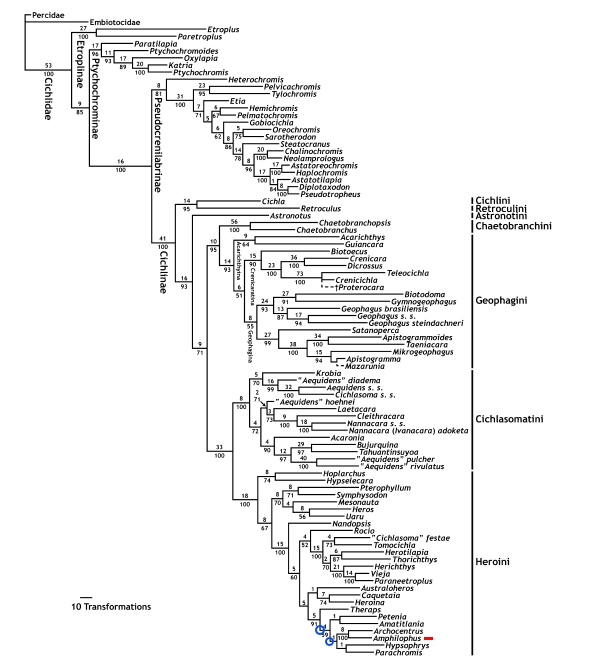Table of Contents
Amphilophus citrinellus (Günther, 1864)
Introduction
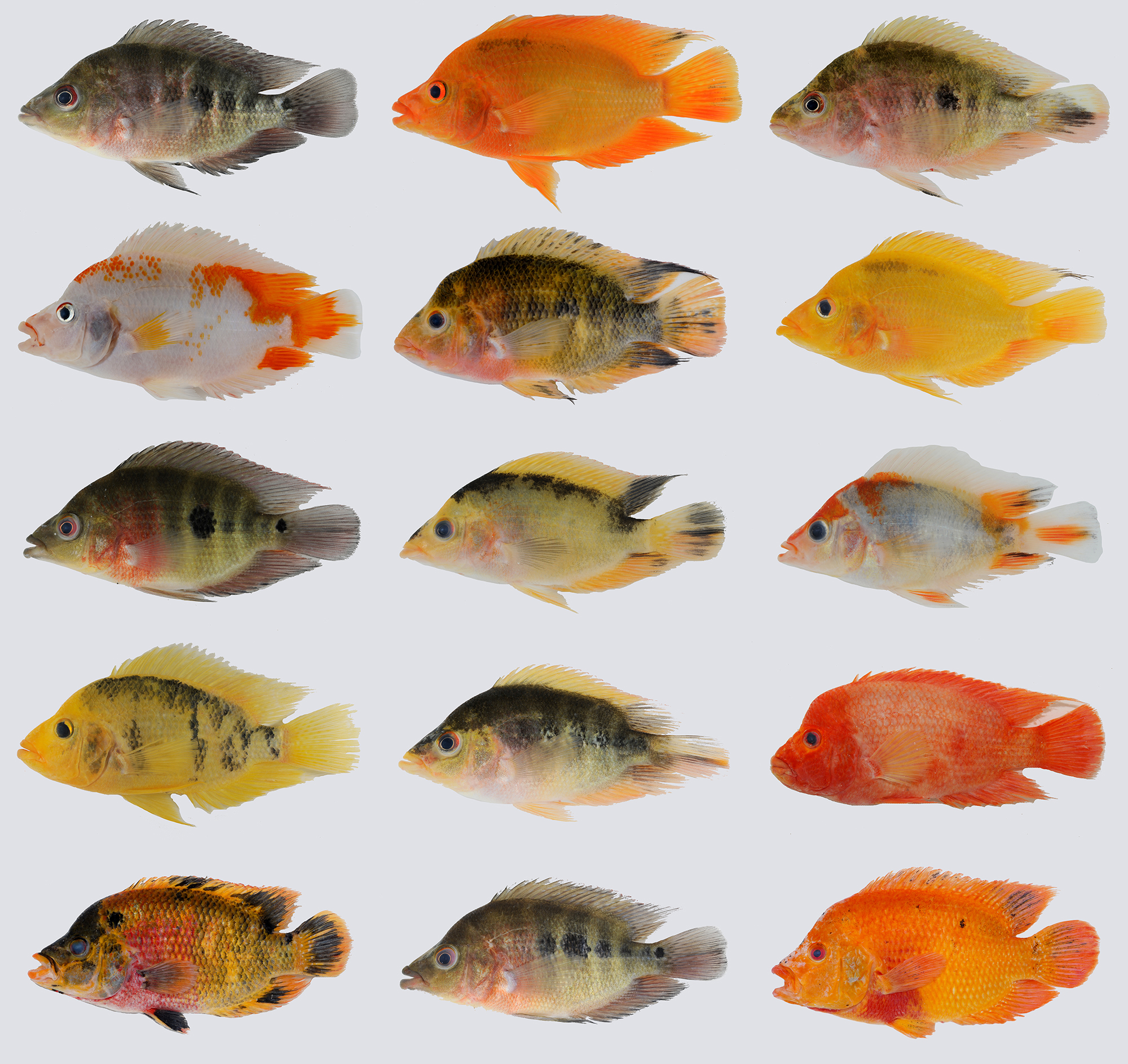 |
| Figure 1: Colour morphs of the Midas Cichlid in Singapore. Photo credit: Tan Heok Hui, published in Singapore Biodiversity Records, used with permission from corresponding author |
Despite what the differences in colourations and body shapes may suggest, there is only one species of fish depicted in the photo above and all of these specimens were collected in Singapore. This species is the Midas Cichilid (Amphilophus citrinellus), so named because of the uniform orange morph (for examples see the top middle and bottom right), which is occasionally referred to as the "gold" morph [1]. It should be noted however that the large variation in morphology has led some researchers to consider the Midas cichlid as a species complex rather than as a single species [2,3,4,5,6,7,8] but the individual species have yet to be defined.
Being a member of Family Cichlidae, the Midas cichlid has attracted much attention from biologists as a model study organism for evolution and speciation [9,10,11,12,13] due to their great amount of intraspecific variation, and potential for rapid speciation. In Singapore, the Midas cichlid was first recorded by Ng and Tan in 2009 and very little research has been done on it. Given that it is a relatively recent introduction and that the Midas cichlid is now present in many urban freshwater bodies in Singapore [14,15,16,17,18], the Midas cichlid represents a unique opportunity to study the adaptation and speciation process of cichlids in a new habitat as it faces habitat conditions and species assemblages that differ greatly from its native home range. As such, this website is intended to facilitate research in the Midas cichlid by compiling information about the species to be easily accessed by researchers and students.
Distribution in Singapore
Before discussing the distribution of the Midas cichlid in Singapore, it is important to recognize that artificial and natural freshwater habitats in Singapore vary greatly in terms of their habitat parameters and species assemblages [19]. Of particular note is that species in natural freshwater bodies tend to only comprise of native species whereas those in artificial water bodies typically comprise of only non-native species [19]. This difference in species composition is due to the different habitat conditions found within natural and artificial water bodies as natural water bodies in Singapore are mostly small, shallow forest streams with acidic pH while artificial water bodies are canalized waterways, ponds, or large reservoirs which are less acidic and are the equivalent of large open water bodies like lakes, which do not occur naturally in Singapore [19]. Since native species are better adapted to the conditions in natural environments, many of them are poorly adapted to these artificial habitats, leaving an opening for non-native species, most of which are adapted to large open water bodies in their native regions [19]. Conversely, non-native species seem to be unable to compete with native species within natural systems and thus are unable to establish themselves [19].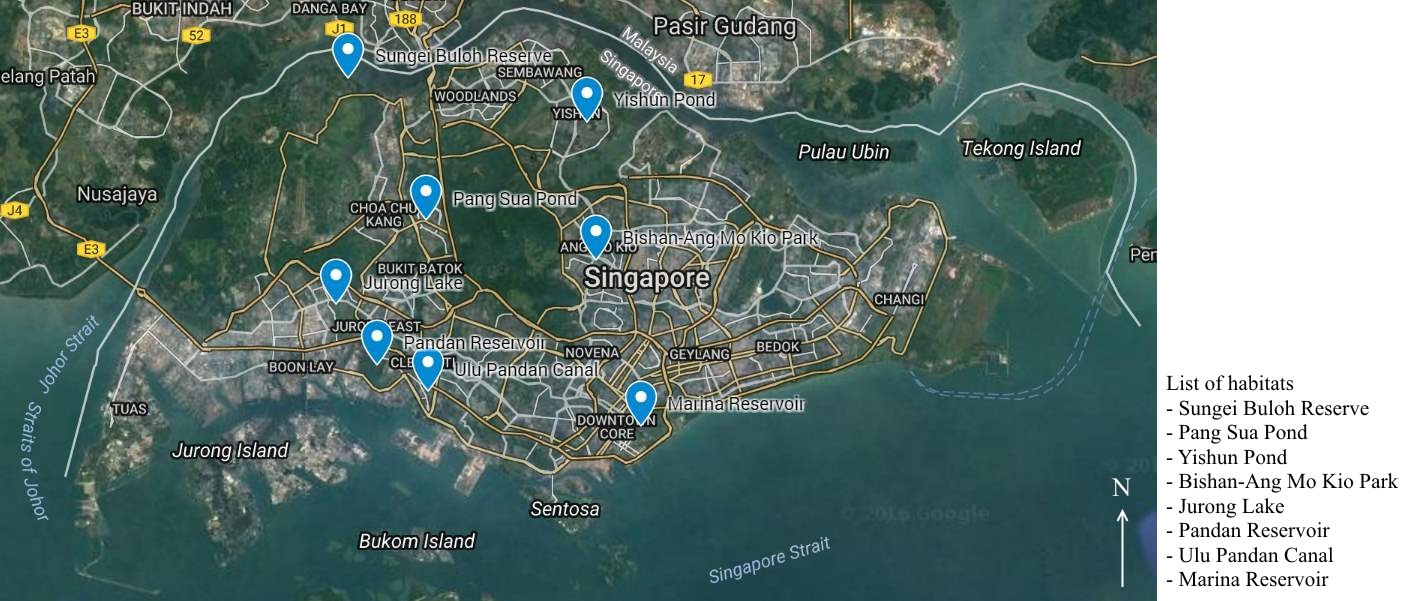 |
| Figure 2: Recorded locations of Midas Cichlid in Singapore. Image prepared by Lee Juin Bin, base map from Google Maps |
Like other non-natives, the Midas cichlid seems to be unable to establish itself within natural freshwater systems but it has established itself in a wide range of artificial habitats such as stormwater ponds, reservoirs, and concretized waterways (e.g. Yishun Pond, Marina Reservoir, Ulu Pandan Canal) and in mud ponds within Sungei Buloh Wetland Reserve (see Figure 2 above) [14,15,16,17,18]. As the Midas cichlid is unable to establish in natural habitats, it is unlikely to have a major impact on native species in Singapore but given its prevalence in artificial habitats, it might have an impact on the assemblage of non-native species found there but this has yet to be assessed. Aside from this, its presence provides a unique chance to observe adaptation to new habitats as it faces different habitat pressures and competition from other species compared to its native home range, as was previously mentioned.
Distribution in other areas
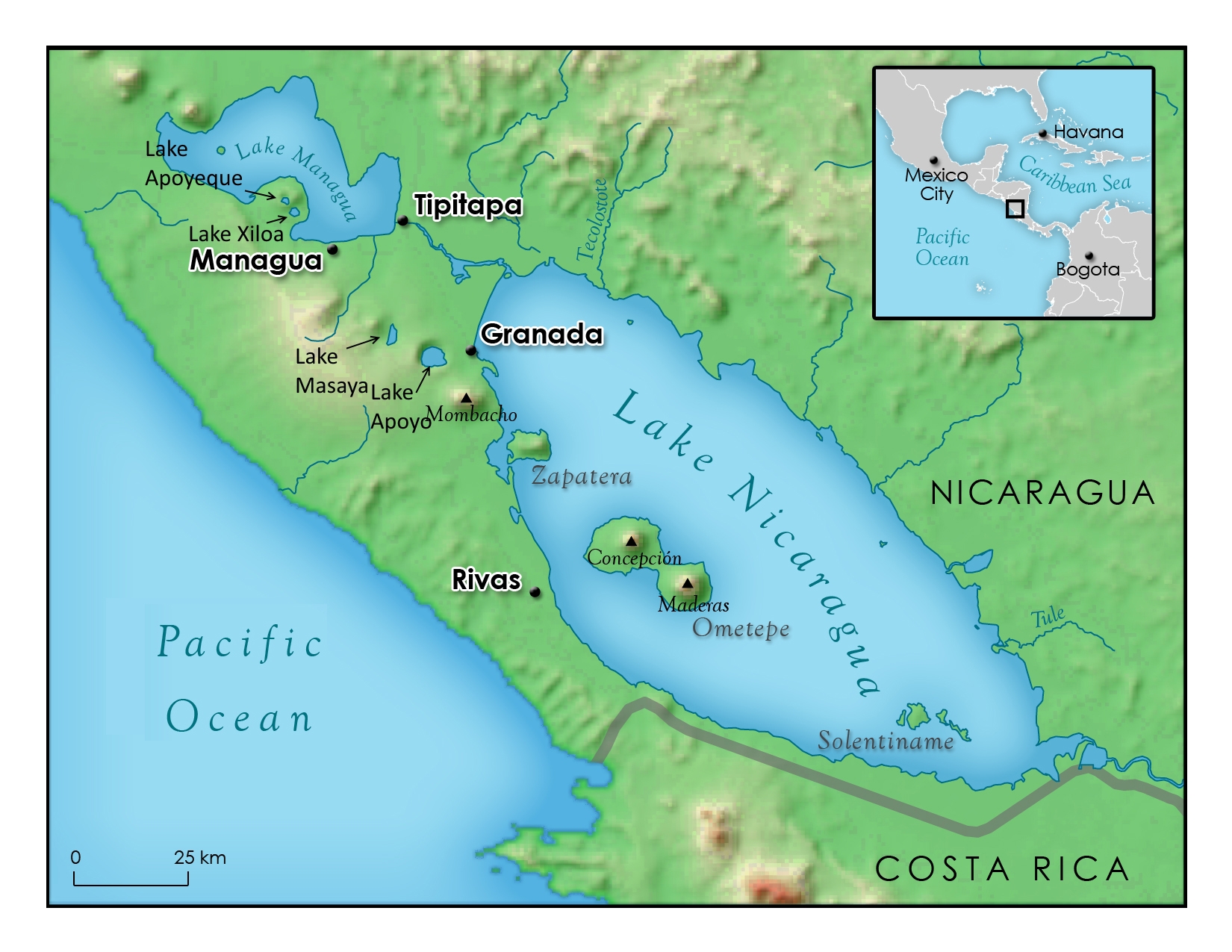 |
| Figure 3: Great Lakes Basin in Nicaragua. Image by Rudyologist, edited to include labels for smaller crater lakes by Lee Juin Bin used under CC BY-SA 4.0 |
While this page is mostly focused on Singapore's populations of Midas cichlids, most research on the species has be done with populations within Nicaragua thus it is important to consider the other places where the Midas cichlid can be found.
The Midas cichilid has a relatively limited natural distribution that covers only Nicaragua and Costa Rica [1]. Within Nicaragua, the Midas cichlid can be found within the Great Lakes Basin which contains two large lakes, Lake Nicaragua and Lake Managua, and an assortment of smaller crater lakes (e.g. Lake Apoyo and Lake Masaya) (see Figure 3) [20] and within Costa Rica it has been found within coastal lagoons in North Western Costa Rica [1]. Aside from its native range, the Midas cichlid is also reported to have been introduced and established in various habitats within North America, Hawaii, Puerto Rico, Taiwan, and Singapore [14,21,22,23,24].
Physical appearance
The Midas cichlid has a laterally compressed body, relatively fleshy lips and has also been observed to grow to a standard lengths (snout till start of tail fin) of 200mm and above [20, personal observation] and the head makes up approximately a third of the standard length [20,25]. During the mating season, some individuals may develop a nuchal hump, a swelling on the forehead that is soft to the touch [20]. This trait can be found in both sexes but those developed by females are generally much smaller and relatively inconspicuous compared to the males's [20]. In captive specimens, the nuchal hump could grow to grotesque proportions [20] as shown by the image below.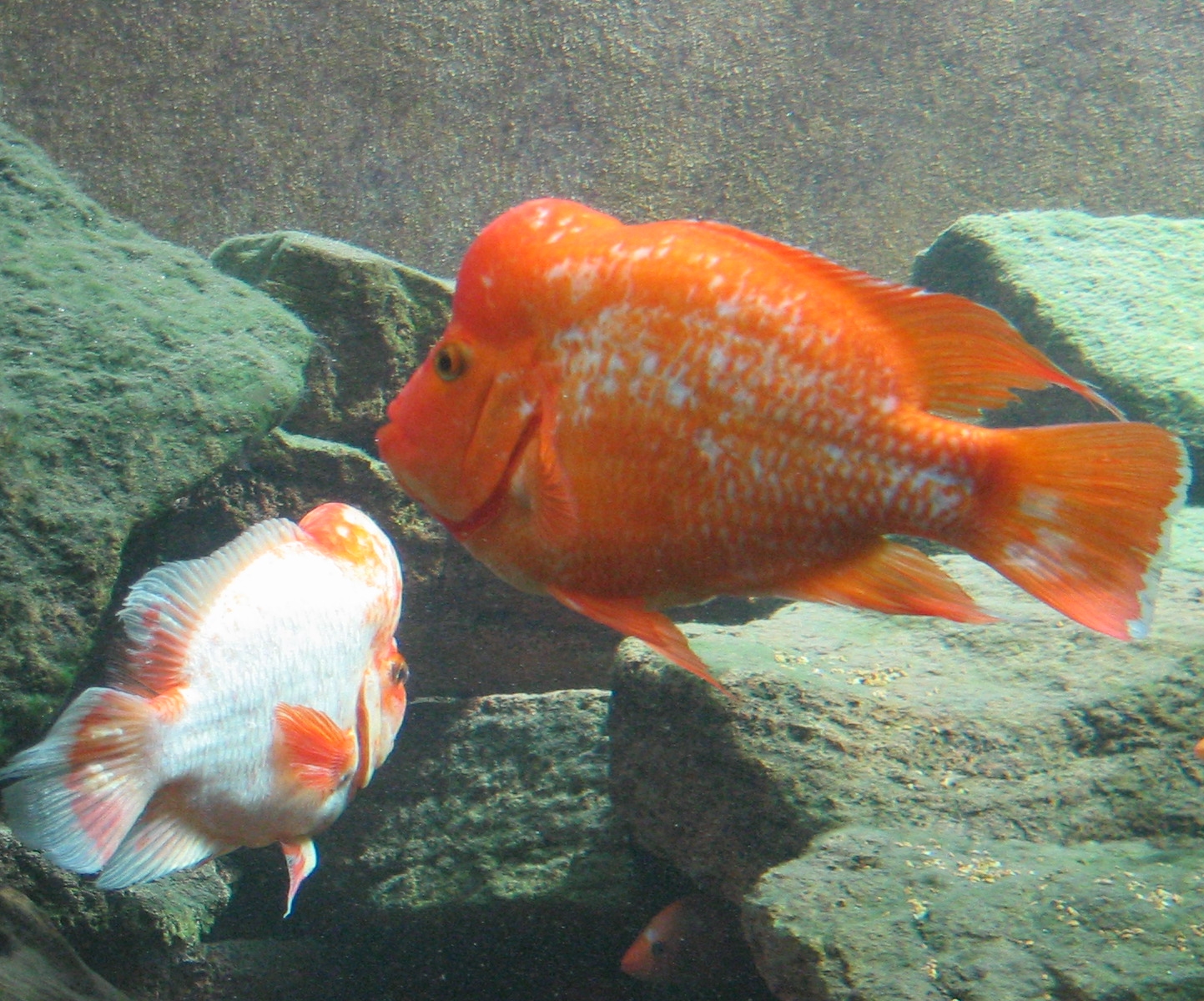 |
| Figure 4: Captive Midas cichlids with nuchal humps. Photo credit: Omnitarian, used under CC BY-SA 3.0 |
As previously mentioned, the Midas cichlid displays a wide variety of colouration, ranging from including white, orange, yellow, and red morphs [1]. Some individuals are also variegated with splotches of colour on their body instead of a single uniform colour [16]. In Singapore, most morphs can be found as shown from Figure 1 but the barred morph (Figure 5) and a uniform bright orange morph (Figure 6) are most commonly seen. It should be noted that juveniles are typically barred and adults with an orange morph would lose the melanin in their skin during maturation leaving behind the orange colouration but those with a barred morph will retain the melanin in their skin [1].
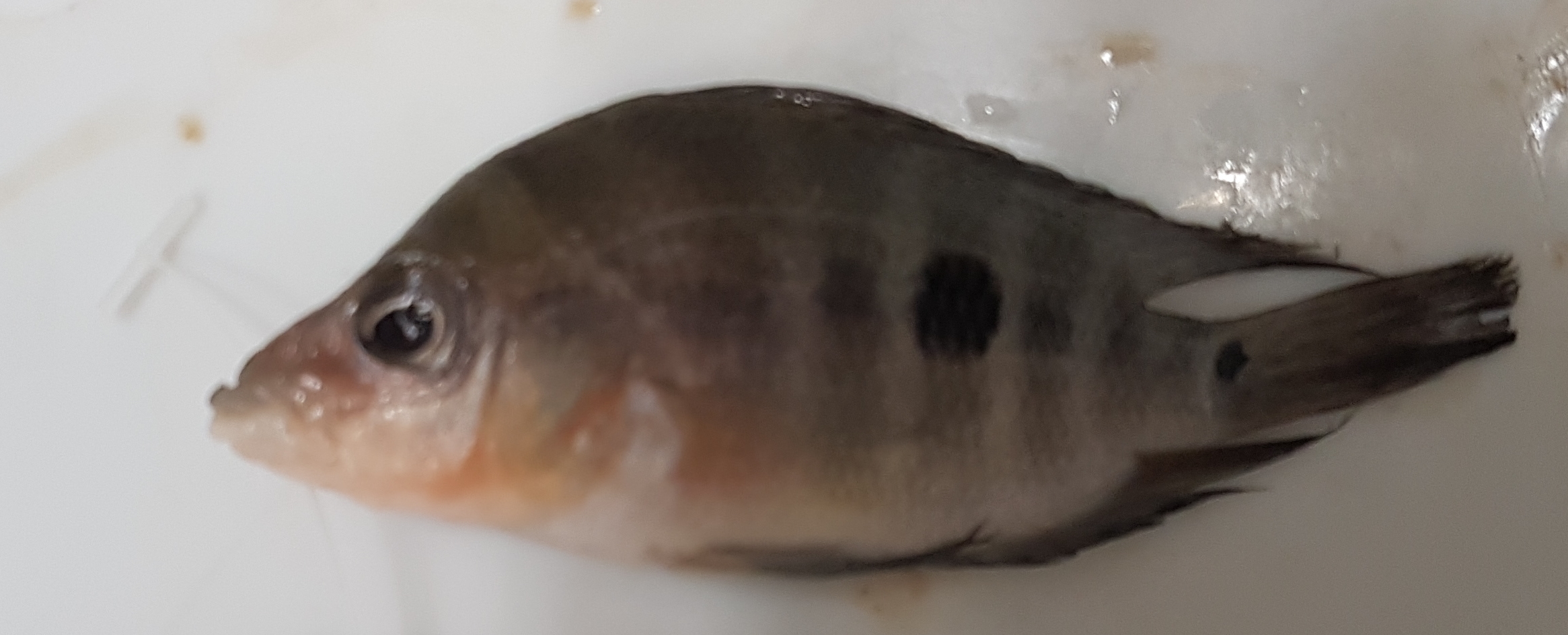 |
| Figure 5: Barred morph (standard length: 66mm). Photo credit: Lee Juin Bin |
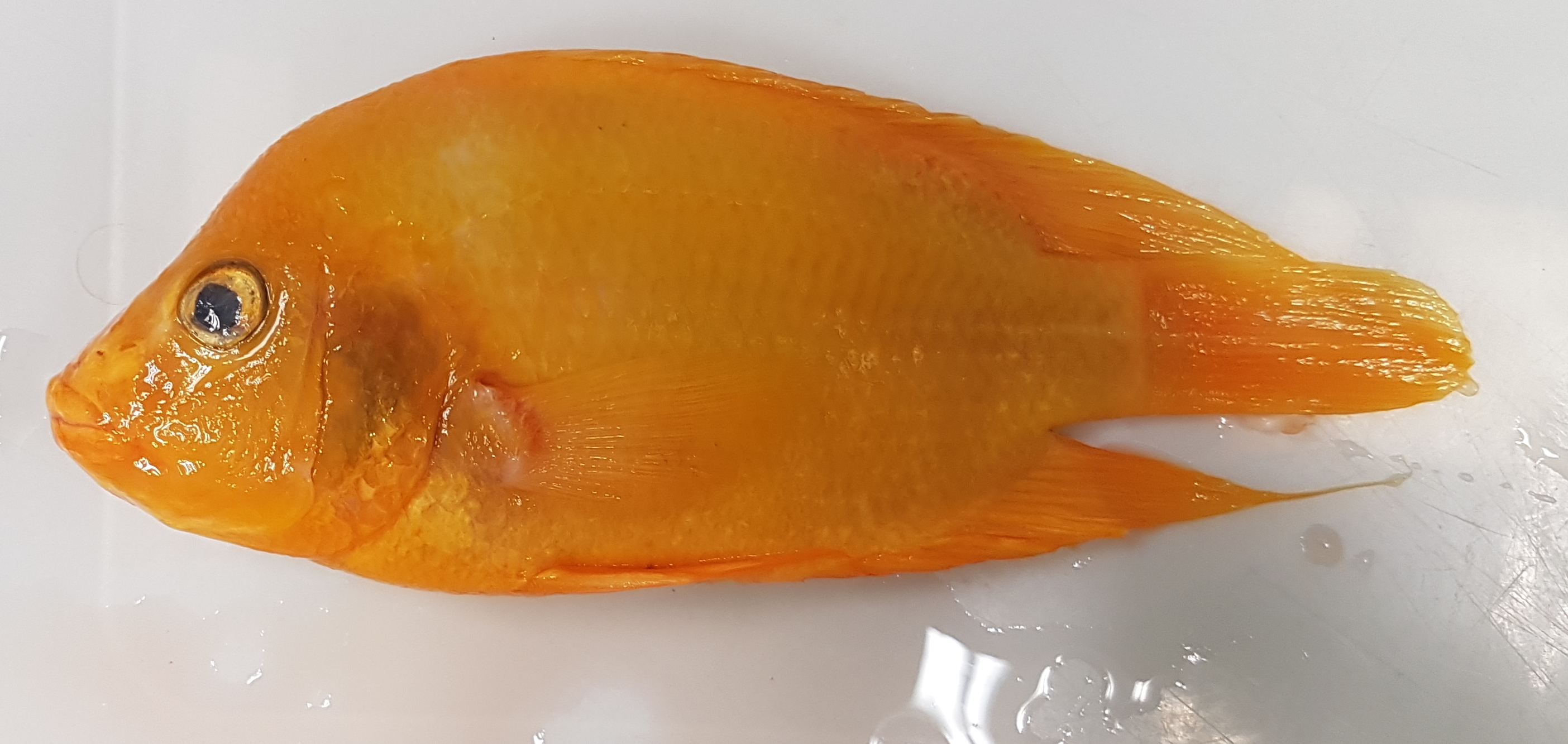 |
| Figure 6: Gold morph (standard length: 122mm). Photo credit: Lee Juin Bin |
A special jaw
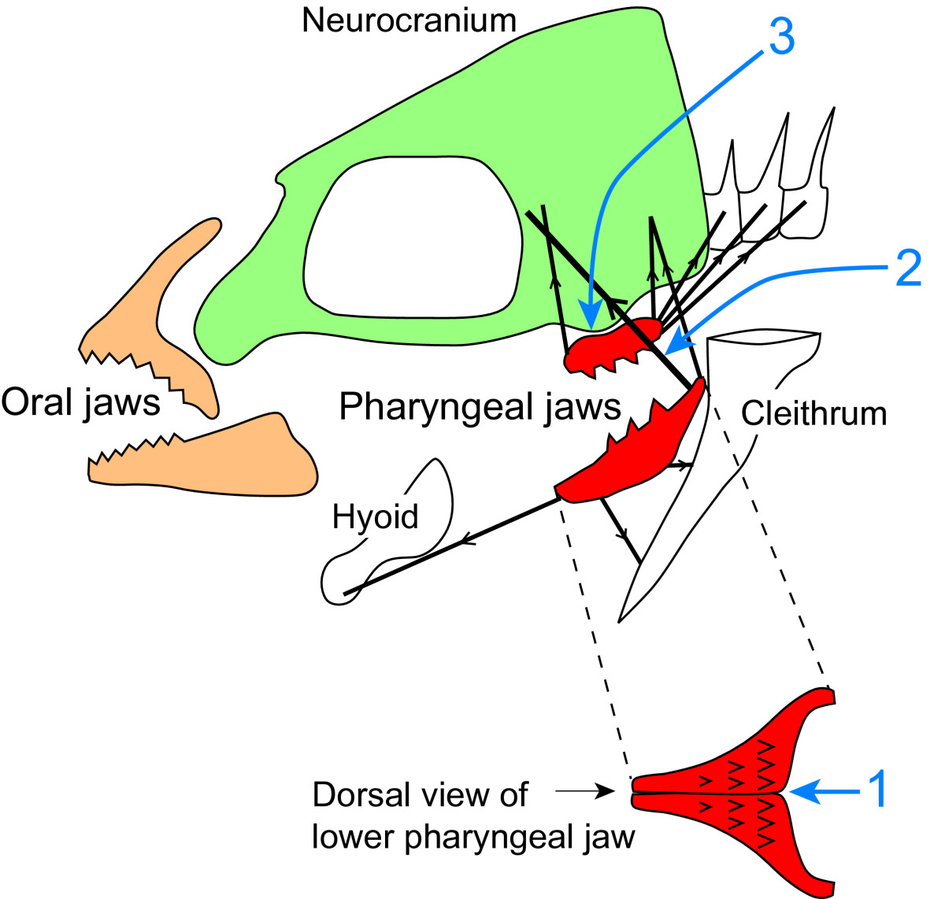 |
| Figure 7: Location of the pharyngeal jaw. Photo credit: Mabuchi et al. Used under CC BY 2.0 |
While discussing the appearance of the Midas cichlid, it is important to discuss another part of its morphology, the pharyngeal jaw, a second set of jaws found in Labriod fishes (Suborder Labroidei). These pharyngeal jaws are found just in front of the throat [10](see Figure 7 above) and they play an important role in the diet of the Midas cichlids as they can possess specialized dentition which influences how effective the fish is at processing different diets.
*Due to problems obtaining permission to use the figure, Figure 8 has been removed, please refer to Figure 2 in the paper hyperlinked here*
For the Midas cichilid, there are two morphs of pharyngeal jaws, the papilliform morph with pointed narrow teeth and are typically thinner and the molariform morph which is typically thicker with thick flat teeth [10]. The image above shows the lower phrayngeal jaws of both morphs taken from a species known as Minkley's cichlid (Herichthys minckleyi) (papilliform on the left, molariform on the right) as an example of how the jaws look like.
As mentioned, the pharyngeal jaws can play a important role in the diet of the Midas cichlid and this has been confirmed by studies that found that individuals with molariform teeth were more effective in handling hard shelled prey whereas individuals with papilliform teeth were more effective in handling soft prey [10]. Further evidence of the jaw's influence was found by observing the growth of Midas cichlids in different environments as all juveniles have a papilliform morph and the proportion of adults with a molariform morph was dependent on how many snails were available to the fish [9]. The more snails there were, the higher the proportion of molariform adults, suggesting that diet drives the morphology of the phrayngeal jaw as well. These differences in pharynageal jaw morph also correspond with differences in body shape with molariform individuals being observed to have a blunter head and deeper body compared to papilliform individuals [10].
Diagnosis
Due to the large variation in morphology and colouration, it is difficult to identify tangible non-subjective characters that can be used to reliably identify the species as the body form varies from elongate forms to deep forms and markings present on one colour morph would be absent in other colour morphs [25]. As such, most diagnosis of species appears to be done relative to other species that are known to be present within the habitat being studied. For instance, Barlow & Munsey (1976) diagnoses the Midas cichlid in the Great Lakes of Nicaragua as having "thinner lips, a deeper body, steeper forehead, and higher fins" when compared to Amphilophus labiatum. However, even these subjective differences breakdown in the some of the crater lakes of Nicaragua as some individuals have developed fleshy lips and slender bodies, possibly due to the absence of Amphilophus labiatum in these lakes [1]. As a result of this, researchers hoping to identify the Midas cichlid from gross morphology would have to be very familiar with it and other species within the habitat and recognize that the morphology varies from habitat to habitat [1].Within Singapore, the identification of the Midas cichlid is easier as there are not many species that look similar to the Midas cichlid in Singapore. For one, there are no other fish species with a similar body shape and displays yellow or orange colouration. As for the barred morph, the Mayan cichlid (Cichlasoma urothamus) looks similar and can be found in the same habitats as the Midas cichlid but comparing the two species side by side reveals several diagnostic differences [16]. The most diagnostic and easily used is to compare the ocellus (the black spot) present just before the tail. For the Mayan cichlid, the ocellus is larger and more distinct compared to the Midas cichlid and there is a white ring around it while the ring is absent in the Midas cichlid. Another usable character is that the black spot in the middle of the fourth bar on the body is more clearly defined on the Midas cichlid while it is not as well defined on the Mayan cichlid [16].
Habitat
As mentioned previously, the Midas cichlid can be found in a wide variety of habitats within Singapore, including concretized water ways, urban ponds, and reservoirs [14,15,16,17,18]. The presence of Midas cichlids in reservoirs and ponds are expected as they are typically found within lakes in their native ranges [1] and are adaptable to a wide variety of depths (shallow up to 35m in depth) and a variety of substrates (mud, sand, and gravel) [1]. The presence of Midas cichlids within mud ponds within Sungei Buloh is not surprising either as they have been found in coastal lagoons within Costa Rica [1], showing that they are able to tolerate saline habitats to some degree. Their prevalence within concretized waterways is a little surprising as they were recorded to not be prevalent within rivers in Nicaragua [1], possibly indicating that conditions are sufficiently different (perhaps in terms of the competition it faces) in Singapore for it to colonize these habitats as well.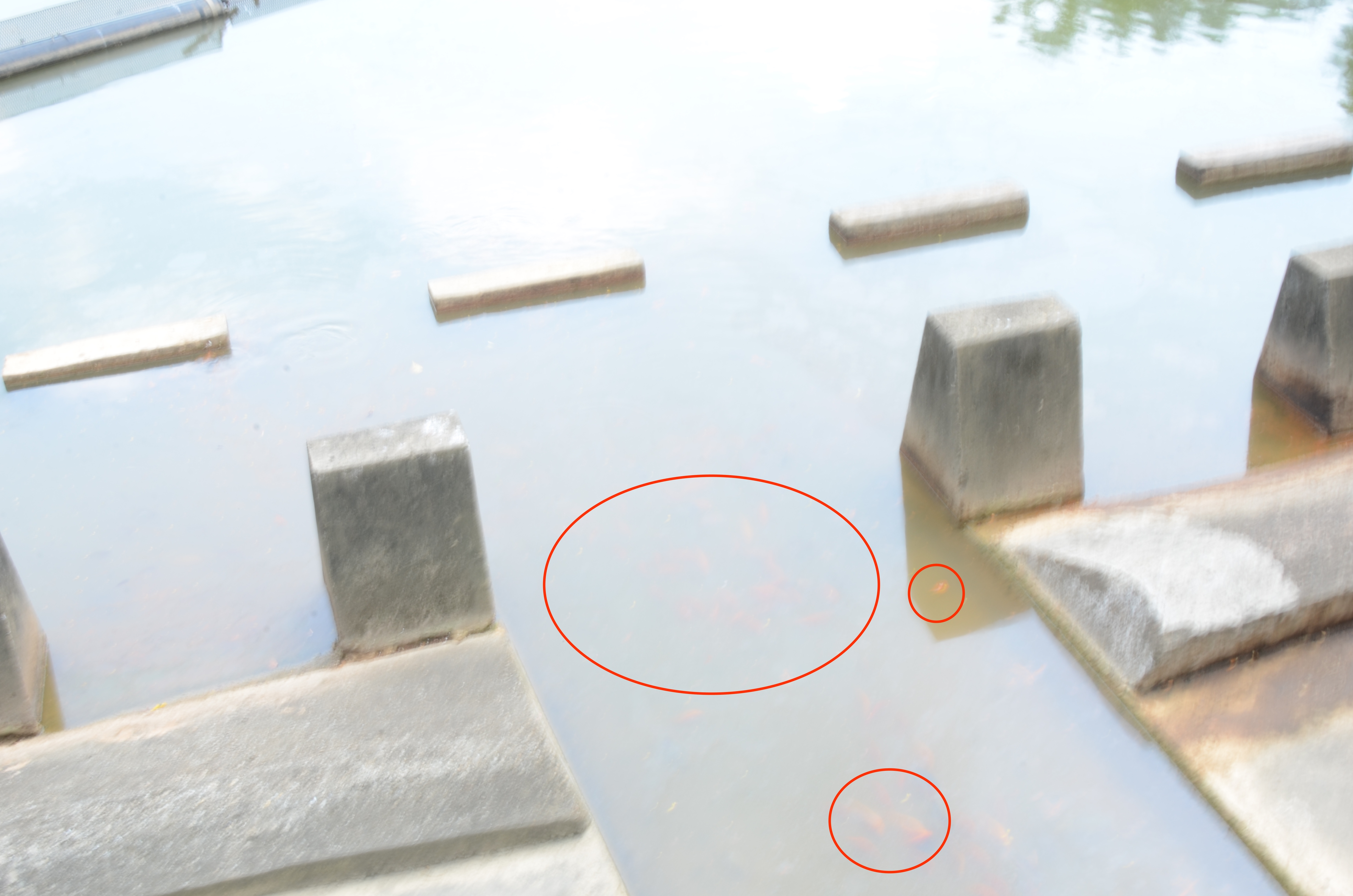 |
| Figure 10: Midas cichlids in Yishun Pond, red circles mark where fishes are present. Photo credit: Lee Juin Bin |
Despite its wide habitat tolerance, the Midas cichlid does seem to have a preference for benthic habitats as it is typically observed to stay near the bottom of lakes in Nicaragua and if threatened it would try to flee into deeper waters [20]. Another observation about the Midas cichlids habitat choice is that it appears to prefer to stay near banks or rocky outcrops (personal observation). This is something that has been observed in the Midas cichlid's native range as well as it is observed to stay near cover like rocks, fallen bushes, or trees in Nicaragua [20]. It uses its cover effectively to evade threats and if it is unable to escape, it is able to lodge itself within cover by using the spines on its median fins [20]. When cover is not available, the Midas cichlid has been observed to excavate holes in the substrate that are large enough for them to hide in when upright [20].
Diet
The Midas cichlid is an omnivore when it is an adult feeding on a variety of food sources including algae, snails, fishes, and insects [20,26]. The adults have also been observed to use a variety of feeding methods including sifting through the sediment, biting off algae, scraping substances like Aufwuchs from hard substrates, or simply taking food from open water [20]. As for the fry, they typically feed on plankton, small invertebrates like copepods [20,26], and mucus from their parents [27].Life cycle
In its native range, the Midas cichlid typically places its eggs on the ceilings of caves [20]. In Singapore, it has not been assessed where the Midas cichlid lays its eggs as there are no caves but they possibly use small rocky ledges as they have been observed with fry close to rocky banks (personal observation). When hatched, the parents care for the larvae by removing substrate from crevices or under rocks to hide the larvae in [20]. As the larvae mature into fry, they leave their hiding places but will stay close to the parents in large schools [20]. At this stage, if the parents feel threatened, they would retreat into caves and the larvae would hide under them [20]. When the fry are around 20mm long, they start to become independent of their parents, swimming away from the cave and into the open where they will mature into sexually reproductive adults [20].source
Human uses - Aquarium
The Midas cichlid is a popular aquarium fish because of the bright colourful colouration of several morphs [28,29]. Aside from being sold as aquarium fish, the Midas cichlid is also used to hybridize with other cichlid species to give rise to other aquarium species like the blood parrot (Amphilophus citrinellus x Paraneetroplus melanurus) [18]. |
| Figure 11: Blood parrot hybrid. Photo credit: PorcPuff, used under CC BY-SA 3.0 |
Taxonomy and systematics
Systematics
(source from Encyclopaedia of Life) [30]Phylum: Chordata
Class: Actinopterygii
Order: Perciformes
Suborder: Labroidei
Family: Cichilidae
Genus: Amphilophus
Synonyms
Heros citrinellus, Heros basilaris, Herichthys citrinellus, Cichlasoma granadense, Cichlasoma citrinellum, Archocentrus citrinellus [30,31]Description
The Midas cichlid was first described under the name Heros citrinellus by Albert Günther in 1864 from three specimens collected in Lake Nicaragua [32]. Most of the description was done by comparing ratios of lengths of different body parts such as the length of the head compared to the standard length. It also included characters such as the snout not being obtuse and that the first dorsal spine is found above the upper end of the operculum [32]. Günther also described the fish as being lemon-coloured, either uniformly or with black blotches on the back and vertical fins [32], showing a lack of recognition for the colour polymorphism displayed by the species, probably due to Günther describing the species from only three specimens. This page will not go much into Günther's description of the species as he made them from only three specimens and the description is not definitive for all populations [1] |
| Figure 12: Register of specimens submitted by Gunther. Photo credit: The Trustees of the Natural History Museum, London, used under CC0 1.0 |
The description of the Midas cichlid was updated in 1907 by Seth Eugene Meek and placed under the genus Cichlasoma [25]. The description again was based mostly on ratios but Meek does recognize the colour variation and described the barred colour morph ("colour variable, typical color dark olivaceous; sides with seven dark bars; usually a dark spot on 4th bar just below the lateral band" [quoted from Meek, 1907]) [25]. Meek also recognizes the morphological variation within the species as evident from the following quote "Of all the species fishes in these lakes, this one is by far the most variable. I made many repeated efforts to divide this material listed below in from two to a half-dozen or more species, but in all cases I was unable to find any tangible constant characters to define them. To regard them as more than one species meant only to limit the number by the material at hand, and so I have lumped them all in one", showing that Meek viewed the Midas cichlid as a highly polymorphic fish [25]. Other useful characters for diagnosis identified by Meek (including updates by Barlow & Munsey) are included below in point form.
- Head length slightly above one third of standard length
- Body depth approximately half of standard length (highly variable)
- 15 to 17 dorsal fin spines [from Barlow & Munsey]
- Dorsal fins increase in length rapidly up till the fifth spine and gradually up till the last spine
- 10 to 13 anal fin spines [from Barlow & Munsey]
- Five rows of scales on cheek
- Caudal peduncle is deeper than long
Currently, the Midas cichlid is placed in genus Amphilophus but several researchers are challenging the description of Midas cichlid as a highly polymorphic species but rather claim that the Midas cichlid is a species complex comprising of several species that have not been delimited yet [6,33]. As a result, a number of new species have been decribed bringing the species count of the Amphilophus genus to anywhere between three or nine depending on the author [6]. Researchers should however be careful to check which species concept was used to delimit the species before using them as improper use of species concepts may result in meaningless delimitations.
Phylogeny
The phylogenetic tree above is a most parsimonious tree constructed from nine gene subunits (four mitichrondrial [large ribosomal subunit (16S), cytochrome c oxidase subunit I (COI), NADH dehydrogenase four (ND4) and cytochrome b(Cyt-b)] and five nuclear gene regions [histone H3 (H3), recombination activation gene two (RAG2), intro one of the S7 ribosomal protein (S7), Tmo-4C4 (4C4), and Tmo-M27(M27)] and from morphological characters [34].
The tree includes Cichlid genera from Neotropics and use non-cichlid Families Percidae and Embiotocidae together with etropline, pytochochromine, and pseudocrenilabrine Cichlid genera as outgroups [34]. Supports for each node are listed with Bremer supports from above the branch and jackknife resampling proportions (only above 50% listed) listed below the tree.
As can be seen in the tree above, the genus Amphilophus is nested within the tribe Heroini and the node has high supports with 100% resampling from jackknife procedures and a Bremer support of 8. However, it should be noted that the nodes leading up to the node separating Amphilophus and Archocentrus have relatively weak supports (circled in blue), with the node separating Amphilophus and Archocentrus from Hypsophrys and Parachromis having less than 50% resampling from jackknife procedures and a Bremer support of 1. As such more data may find Amphilophus in a different part of the phylogeny tree but likely still within tribe Heroini as the nodes separating Heroini from other tribes have very strong support.
*Due to problems obtaining permission to use the Figure, Figure 14 has been removed. Please refer to Figures 1 and 2 from the paper hyperlinked here*
To look at the relationship between species, the phylogenetic trees above are Bayesian trees between Cichlid species created using the cytochrome b sequence data that end in voucher specimens [35]. The authors of these trees found the genus Amphilophus within a group Amphilophines (marked with a blue line on the left tree) and the relationships within the group are shown in the tree on the right. Interestingly, this tree reveals that Amphilophus is a polyphyletic group [35] (members labelled by red lines) and thus is not a valid taxa, suggesting that classifications of species in genera have to be looked at again. A possible reason for the misclassification has been suggested that classifications have been confounded by convergences in morphology [35]. It should however be noted that Bayesian analysis are only considered to adequately model phylogeny if the model used for the priors either incorporates prior knowledge or manages to model ignorance effectively [36] and the model for priors used in this phylogeny analysis was not stated. As such further research should be done to confirm if the genus is truly polyphyletic. Furthermore, the above tree does not include the arrow cichlid (Amphilophus zaliosus), a species known to be found in the Nicaraguan lake basins together with the Midas cichlid [1].
Another point to note when discussing the phylogeny of the Midas cichlid is that new species are still being described at this point [6] and thus prior analysis may actually have lumped multiple species together into a single species for analysis. Furthermore, a study by Geiger et al (2010) found that morphologically distinct specimens from the same lake are more genetically alike compared to morphologically similar specimens from different lakes, showing rapid convergent evolution. This suggests that the Midas cichlid is capable of rapid speciation and as such specimens collected from different areas would be expected to be genetically different. This has implications on the phylogeny as phylogeny trees created from one locality may not be valid for the other areas that the Midas cichlid are found in.
To summarize, phylogenetic research on the Midas cichlid have found with reasonable certainty that the genus Amphilophus is found within tribe Heroini but the validity of the genus should be questioned as a Bayesian analysis on the cytochrome b sequence has found that the genus is polyphyletic. Furthermore, due to the description of new species within the Midas cichlid species complex and the rapidity of speciation, researchers should be careful when applying phylogeny trees to their research as multiple species may be lumped together and the data may not be applicable when the location is different.
Type specimens
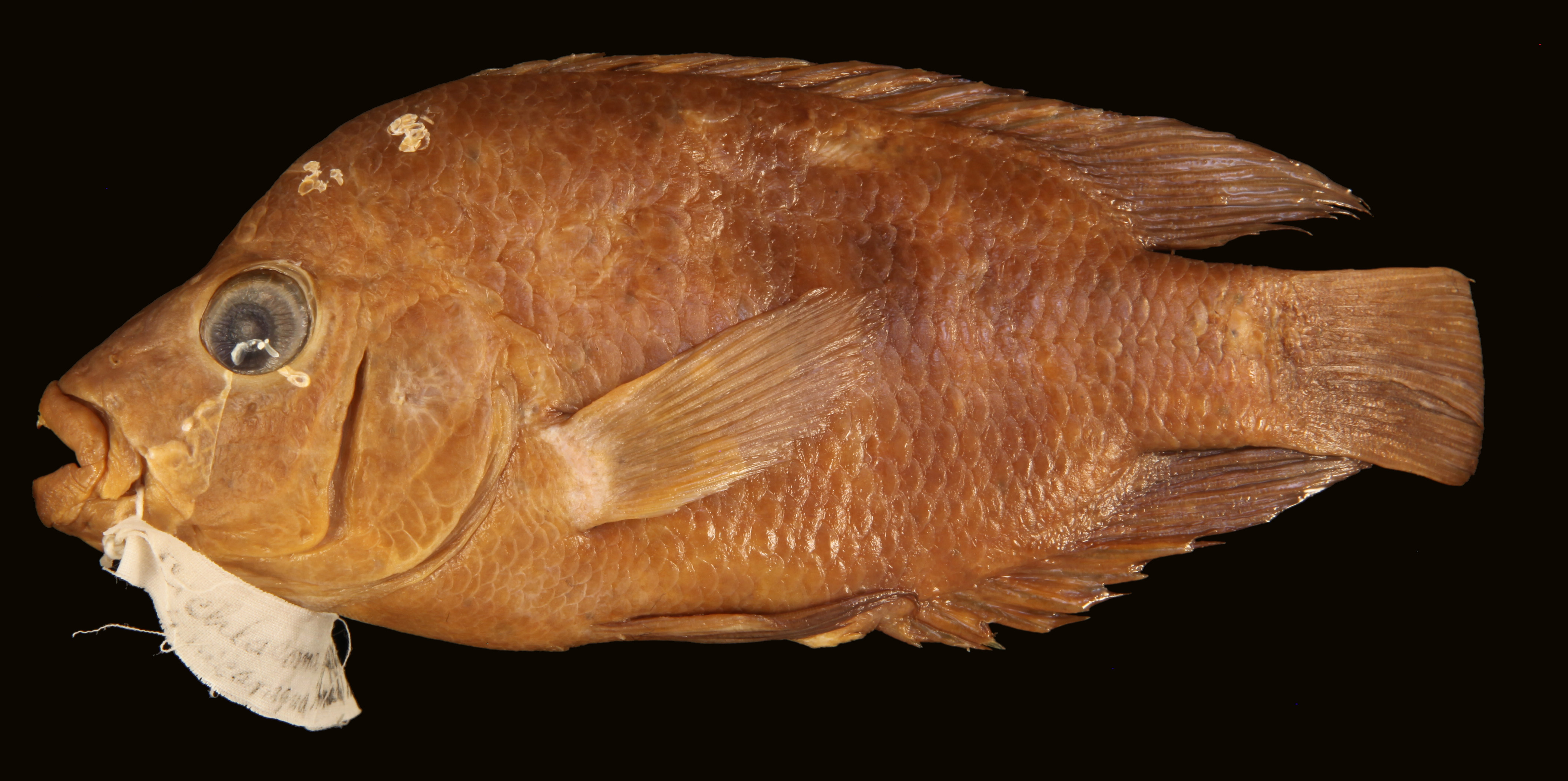 |
| Figure 15: Holotype of Cichlasoma grandense (FMNH 5951). Photo credit: Field Museum of Natural History. Used under CC0 1.0 |
No holotypes are assigned for the Midas cichlid but there are syntypes, as well as paratypes and holotypes for its synonyms [31]. The three specimens used by Günther for identification in 1864 are stored in the Natural History Museum (London) as syntypes under the catalogue number NHMUK 1864.1.26.201-20333 but it does not seem that a lectotype was defined. Other type specimens and their catalogue numbers are listed below [31]. Note that Cichlasoma granadense was described in 1907 by Meek but was eventually reassigned as a junior synonym of Amphilophus citrinellus, thus the types are listed here as well but they are not valid types for the description of the Midas cichlid.
- Paratypes under synonym Cichlasoma granadense by Meek, 1907 in Field Museum of Natural History (Zoology) Fish Collection, catalogue number FMNH 5952, FMNH 5949, FMNH 5950, FMNH 5948
- Holotype of synonym Cichlasoma granadense by Meek, 1907 in Field Museum of Natural History (Zoology) Fish Collection, catalogue number FMNH 5951
- Cotype in Natural History Museum (London), catalogue number BMNH 1905.3.27.4
References
Text
- Barlow, G.W., & Munsey, J.W. (1976). The Red Devil-Midas-Arrow Cichlid species complex in Nicaragua. Investigations of the Icthyofauna of Nicaraguan Lakes. Retrieved 6 November 2016 from http://digitalcommons.unl.edu/ichthynicar/23/
- McKaye, K. R., Stauffer, J. R., van den Berghe, E. P., Vivas, R., Perez, L. L., McCrary, J. K., Waid, R., Konings, A., Lee, W.J., & Kocher, T. D. (2002). Behavioral, morphological and genetic evidence of divergence of the Midas cichlid species complex in two Nicaraguan crater lakes. Cuadernos de Investigación de la UCA, 12, 19-47.
- Stauffer Jr, J. R., McCrary, J. K., & Black, K. E. (2008). Three new species of cichlid fishes (Teleostei: Cichlidae) from Lake Apoyo, Nicaragua. Proceedings of the Biological Society of Washington, 121(1), 117-129.
- Elmer, K. R., Fan, S., Gunter, H. M., Jones, J. C., Boekhoff, S., Kuraku, S., & Meyer, A. (2010). Rapid evolution and selection inferred from the transcriptomes of sympatric crater lake cichlid fishes. Molecular ecology, 19(s1), 197-211.
- Elmer, K. R., Kusche, H., Lehtonen, T. K., & Meyer, A. (2010). Local variation and parallel evolution: morphological and genetic diversity across a species complex of neotropical crater lake cichlid fishes. Philosophical Transactions of the Royal Society B: Biological Sciences, 365(1547), 1763-1782.
- Geiger, M. F., McCrary, J. K., & Schliewen, U. K. (2010). Not a simple case–A first comprehensive phylogenetic hypothesis for the Midas cichlid complex in Nicaragua (Teleostei: Cichlidae: Amphilophus). Molecular Phylogenetics and Evolution, 56(3), 1011-1024.
- Barluenga, M., & Meyer, A. (2010). Phylogeography, colonization and population history of the Midas cichlid species complex (Amphilophus spp.) in the Nicaraguan crater lakes. BMC Evolutionary Biology, 10(1), 1.
- Geiger, M. F., McCrary, J. K., & Stauffer Jr, J. R. (2010). Description of two new species of the Midas cichlid complex (Teleostei: Cichlidae) from Lake Apoyo, Nicaragua. Proceedings of the Biological Society of Washington, 123(2), 159-173.
- Meyer, A. (1990). Ecological and evolutionary consequences of the trophic polymorphism in Cichlasoma citrinellum (Pisces: Cichlidae). Biological Journal of the Linnean Society, 39(3), 279-299.
- Meyer, A. (1989). Cost of morphological specialization: feeding performance of the two morphs in the trophically polymorphic cichlid fish, Cichlasoma citrinellum. Oecologia, 80(3), 431-436.
- Meyer, A. (1990). Morphometrics and allometry in the trophically polymorphic cichlid fish, Cichlasoma citrinellum: alternative adaptations and ontogenetic changes in shape. Journal of Zoology, 221(2), 237-260.
- Seehausen, O. (2006). African cichlid fish: a model system in adaptive radiation research. Proceedings of the Royal Society of London B: Biological Sciences, 273(1597), 1987-1998.
- Kocher, T. D. (2004). Adaptive evolution and explosive speciation: the cichlid fish model. Nature Reviews Genetics, 5(4), 288-298.
- Ng, H. H. & Tan H. H. (2010). An Annotated Checklist of the Non-native Freshwater Fish Species in the Reservoirs of Singapore. COSMOS, 6(1): 95–116.
- Kwik, J. T., Kho, Z. Y., Quek, B. S., Tan, H. H., & Yeo, D. C. (2013). Urban stormwater ponds in Singapore: potential pathways for spread of alien freshwater fishes. BioInvasions Records, 2(3), 239-245.
- Tan, H.H. (2014). Colour forms of the Midas cichlid. Singapore Biodiversity Records, 2014, 98-99
- Lim, K.K.P. (2013). Midas cichlids at Yishun Pond. Singapore Biodiversity Records, 2013, 110.
- Liew, J. H., Tan, H. H., & Yeo, D. C. (2012). Some cichlid fishes recorded in Singapore. Nature in Singapore, 5, 229-236.
- Yeo, D. C. J. & K. K. P. Lim. (2011). Freshwater Ecosystems. In: P.K.L. Ng, R. T. Corlett, H. T. W. Tan, Singapore Biodiversity: An encyclopedia of the Natural Environment and Sustainable Development, Editions Didier Millet, Pp 52–63.
- Barlow, G. W. (1976). The Midas cichlid in Nicaragua. Investigations of the Ichthyofauna of Nicaraguan lakes, 23.
- Welcomme, R. L. (1988). International introductions of inland aquatic species, FAO Fisheries Technical Paper. Issue 294, Food and Agriculture Org.
- Yamamoto, M. N. (1992). Occurrence, distribution and abundance of accidentally introduced freshwater aquatic organisms in Hawaii. State of Hawaii, Federal Aid in Sportfish Restoration, Dingell-Johnson JOR. Freshwater Fisheries Research and Surveys, Project No. F-14-R-16.
- Liang S. H., L. C. Chuang & M. H. Chang. (2006). The pet trade as a source of invasive fish in Taiwan. Taiwania, 51(2):93–98.
- Grana F. (2007). Exotic fishes recently confirmed as established in Puerto Rico. Email from Felix Grana of the Department of Natural and Environmental Resources of Puerto Rico.
- Meek, S.E. (1907). Synopsis of the fishes of the Great Lakes of Nicaragua. Field Columbo Mus. Pub. 121, Zool. Ser. 7:97-132.
- Gottfried, M. D. (1986). Developmental transition in feeding morphology of the Midas cichlid. Copeia, 1986(4), 1028-1030.
- Noakes, D. L., & Barlow, G. W. (1973). Ontogeny of parent-contacting in young Cichlasoma citrinellum (Pisces, Cichlidae). Behaviour, 46(3), 221-255.
- Animal World. (n.d.). Midas Cichlid. Retrieved 6th November 2016 from https://animal-world.com/encyclo/fresh/cichlid/MidasCichlid.php
- Fishbase. (n.d.). Amphilophus citrinellus (Günther, 1864), Midas Cichlid. Retrieved 6th November 2016 from http://www.fishbase.org/summary/4786
- Encyclopaedia of Life. (n.d.). Amphilophus citrinellus, Midas cichlid. Retrieved 6th November 2016 from http://eol.org/pages/608445/overview
- Global Biodiversity Information Facility. (n.d.). Amphilophus citrinellus (Günther, 1864). Retrieved 6th November 2016 from http://www.gbif.org/species/2370102
- Günther, A. (1864). Report on a collection of fishes made by Messrs Dow, Godman, and Salvin in Guatemala. In Rothchild, M.J. (Ed.), Proceedings of the Scientific Meeting of the Zoological Society of London for the year 1864, 144-155.
- Barluenga, M., & Meyer, A. (2010). Phylogeography, colonization and population history of the Midas cichlid species complex (Amphilophus spp.) in the Nicaraguan crater lakes. BMC Evolutionary Biology, 10(1), 1.
- Smith, L., Chakrabarty, P., & Sparks, J. S. (2008). Phylogeny, taxonomy, and evolution of Neotropical cichlids (Teleostei: Cichlidae: Cichlinae). Cladistics, 24(5), 625-641.
- Concheiro-Pérez, G. A. C., Říčan, O., Ortí, G., Bermingham, E., Doadrio, I., & Zardoya, R. (2007). Phylogeny and biogeography of 91 species of heroine cichlids (Teleostei: Cichlidae) based on sequences of the cytochrome b gene. Molecular phylogenetics and Evolution, 43(1), 91-110.
- Pickett, K. M., & Randle, C. P. (2005). Strange Bayes indeed: uniform topological priors imply non-uniform clade priors. Molecular phylogenetics and evolution,34(1), 203-211.
Media
- Tan, H.H. (2014). Colour forms of the Midas cichlid. Singapore Biodiversity Records, 2014, 98-99
- Rudyologist. (2015). Map of Lake Nicaragua and its vicinity. Retrieved 9th November 2016 from https://en.wikipedia.org/wiki/Lake_Nicaragua#/media/File:Lake_Nicaragua_2.jpg. Copyright Information: Creative Commons Attibution-ShareAlike 4.0 International (CC BY-SA 4.0)
- Omnitarian. (2007). Two Midas cichlids at the Shedd Aquarium, Chicago. Retrieved 9th November 2016 from https://commons.wikimedia.org/w/index.php?curid=2440287.Copyright Information: Creative Commons Attibution-ShareAlike 3.0 Unported (CC BY-SA 3.0)
- Mabuchi, K., Miya, M., Azuma, Y., & Nishida, M. (2007). Cichlid pharyngeal jaw apparatus. Retrieved 23rd November 2016 from http://en.citizendium.org/wiki/File:Cichlid_pharyngeal_jaw_apparatus.png. Copyright information: Creative Commons Attribution 2.0 Generic (CC BY 2.0)
- Hulsey, C. D. (2006). Function of a key morphological innovation: fusion of the cichlid pharyngeal jaw. Proceedings of the Royal Society of London B: Biological Sciences, 273(1587), 669-675.
- Kolewolf. (2008). Midas Fry [Youtube video]. Retrieved 9th November 2016 from https://www.youtube.com/watch?v=BGNZkhT6TDI
- PorcPuff. (2007). Blood Parrot. Retrieved 9th November 2016 from https://en.wikipedia.org/wiki/File:BloodParrot.jpg. Copyright Information: Creative Commons Attibution-ShareAlike 3.0 Unported (CC BY-SA 3.0)
- Smith, L., Chakrabarty, P., & Sparks, J. S. (2008). Phylogeny, taxonomy, and evolution of Neotropical cichlids (Teleostei: Cichlidae: Cichlinae). Cladistics, 24(5), 625-641.
- Concehiro-Pérez, G. A., Říčan, O., Ortí, G., Bermingham, E., Doadrio, I., & Zardoya, R. (2007). Phylogeny and biogeography of 91 species of heroine cichlids (Teleostei: Cichlidae) based on sequences of the cytochrome b gene. Molecular phylogenetics and Evolution, 43(1), 91-110.
- Natural History Museum (London). (n.d.). Zoology Accessions Register: Reptiles & Fishes: 1864-1877: Page 9. Retrieved 9th November 2016 from http://www.gbif.org/occurrence/1056121517. Copyright information: Creative Commons Public Domain (CC0 1.0).
- Field Museum of Natural History (Zoology) Fish Collection. (n.d.). Cichlasoma granadense holotype. Retrieved 9th November 2016 from http://www.gbif.org/occurrence/666715665. Copyright information: Creative Commons Public Domain (CC0 1.0).

